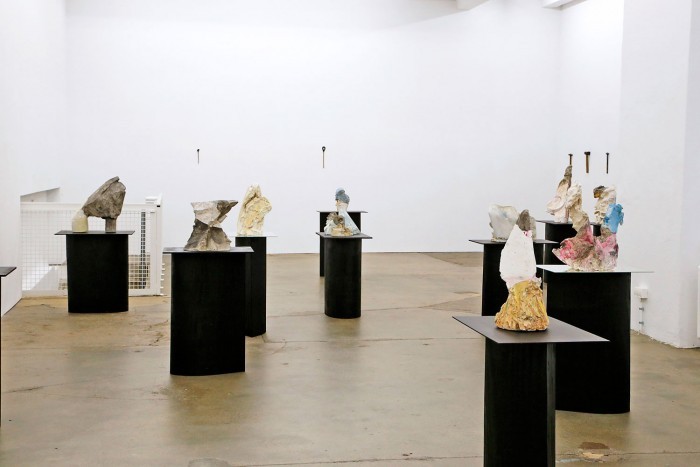Jeroen Jacobs
19 Dec 2014 - 10 Jan 2015
JEROEN JACOBS
Reibung
19 December 2014 – 10 January 2015
Gypsum is a fragile, brittle material. The immaculate white colour of its dull porous surface is always threatened by pollution. In his exhibition at Sommer & Kohl, Jeroen Jacobs puts these material properties to use. In Reibung (friction), Jacobs confronts the material with various everyday objects and substances. By rubbing the plaster with used engine oil, charcoal, printer ink, denim, red wine, energy drinks, rusty nails, clay or grass, he creates discolourations which he sees as a form of patina.
In addition to the lack of resistance against colour contamination, the plaster’s fragility is turned into a central design element. On closer inspection, it becomes noticeable that the contours of the colour planes that make up the composition of the sculptures are actually created by irregular breaklines. These are generated when Jacobs smashes the plaster casts after drying, individually patinating the resulting fragments and finally putting them back together. Patina, in these works, has little to do with the surface treatment related to artificially refining an object. Rather, the artist understands it as a trace left by a ritualistic handling of the material. Jacobs follows his principle to reduce the sculptural gesture to a minimum and to calculate his intervention in such a way that the specific characteristics of the material take care of the rest for him. He also continues this established formula with the black-painted bases of the new series, for which he simply bolted together the ends of large sheets of plywood in such a way that the internal stress of the material curves the plate into an elliptic cylinder.
In addition to the plaster sculptures, two series of everyday objects are displayed in the exhibition. Here the artist appropriates the natural patina of found objects with similar economical measures. In one case by engraving his initials into the steel heads of old hammers and in the other by targeted scorching of used wooden spoons. Both methods refer to well-known handicraft traditions, but are also inspired by the everyday and accidental. The idea for the wooden spoons was formed after the artist had forgotten a spoon on a hot stove; and embossing the hammers goes back to a hammer that had once been given to him engraved with his initials. The patina of these items is unintentional and accidental. Hammer shafts become discoloured by perspiration and dirt. Plaster stains and crumbles. Energy drinks or wine soil the new dress, engine oil absorbs into paving stones, new jeans leave blue streaks on the white leather sofa. In this new group of works Jacobs highlights a range of flaws and mishaps in order to systematically investigate how they can form the basis of a creative process.
Reibung
19 December 2014 – 10 January 2015
Gypsum is a fragile, brittle material. The immaculate white colour of its dull porous surface is always threatened by pollution. In his exhibition at Sommer & Kohl, Jeroen Jacobs puts these material properties to use. In Reibung (friction), Jacobs confronts the material with various everyday objects and substances. By rubbing the plaster with used engine oil, charcoal, printer ink, denim, red wine, energy drinks, rusty nails, clay or grass, he creates discolourations which he sees as a form of patina.
In addition to the lack of resistance against colour contamination, the plaster’s fragility is turned into a central design element. On closer inspection, it becomes noticeable that the contours of the colour planes that make up the composition of the sculptures are actually created by irregular breaklines. These are generated when Jacobs smashes the plaster casts after drying, individually patinating the resulting fragments and finally putting them back together. Patina, in these works, has little to do with the surface treatment related to artificially refining an object. Rather, the artist understands it as a trace left by a ritualistic handling of the material. Jacobs follows his principle to reduce the sculptural gesture to a minimum and to calculate his intervention in such a way that the specific characteristics of the material take care of the rest for him. He also continues this established formula with the black-painted bases of the new series, for which he simply bolted together the ends of large sheets of plywood in such a way that the internal stress of the material curves the plate into an elliptic cylinder.
In addition to the plaster sculptures, two series of everyday objects are displayed in the exhibition. Here the artist appropriates the natural patina of found objects with similar economical measures. In one case by engraving his initials into the steel heads of old hammers and in the other by targeted scorching of used wooden spoons. Both methods refer to well-known handicraft traditions, but are also inspired by the everyday and accidental. The idea for the wooden spoons was formed after the artist had forgotten a spoon on a hot stove; and embossing the hammers goes back to a hammer that had once been given to him engraved with his initials. The patina of these items is unintentional and accidental. Hammer shafts become discoloured by perspiration and dirt. Plaster stains and crumbles. Energy drinks or wine soil the new dress, engine oil absorbs into paving stones, new jeans leave blue streaks on the white leather sofa. In this new group of works Jacobs highlights a range of flaws and mishaps in order to systematically investigate how they can form the basis of a creative process.

